Persia is one of the oldest civilizations on this planet. Thanks to its geographical location along the Silk Road in the Middle East, the Persian cuisine is influenced by many cultures, including Russian, Greek, Asian, and Armenian.
Thanks to the abundance of exotic spices that were available through the Silk Road trade, ancient Persian cooks tried lots of exciting spice combinations. And they like it. Up until today, Iranian dishes use lots of spices and herbs that give Persian dishes very strong aromas and tastes. For this reason, the Persian cuisine has been gaining in popularity also in the western world in the last decades.
Unlike the Indian cuisine, which also uses a lot of spices, Persian dishes are generally not spicy. And therefore more suitable for those who are sensitive to chili.
Exploring Persian herbs is a little like taking and unlocking a gold chest: the blinding sight of rose petals and greenish cardamom is followed only by the strong smell and elegant taste of saffron or turmeric.
Overview of the most common Persian spices
Dried Limes
Dried limes, known as limoo amani in Iran are an important spice in the Persian cuisine. The dried limes are dark brown or black and are available whole or as a ground lime powder. Dried limes are used to add a special sour flavor to stews and soups such as Ghormeh Sabzi and Gheymeh. To flavor a dish with limoo amani, the lime can be either used whole or you can grind it up in a food processor or coffee grinder and only add a few sprinkles to the dish.
To put this spice to the food as a whole, you have to fork it and create holes in the outer layer. This helps the stew to hydrate the lime, releasing that incredible rich and slightly sour taste. You can eat the dried lime alongside your main course, and you can squeeze its juice into stews and remove the rest of the lime after stewing.
However, in contrast to some other spices such as bay leaves or cinnamon sticks that are usually removed from the dish after cooking, you may also cut the softened limes and eat them along with the dish.
Saffron
Saffron is one of the most important spices in Persian cuisine because of its distinctive fragrance for flavoring appetizers, sweets, and rice. The red spice is renowned for its high price. In fact, it is the most expensive spice in the world. But, surprisingly, a little of it goes a very long way. It just requires a pinch or less to bring out its taste in the entire dish. And these small amounts required for most recipes are affordable also for normal citizens like us.

To make the most of the spice when cooking, crush the saffron with a mortar and a pestle or a blender. After that, soak it in lukewarm water for around thirty minutes before adding it to your dish. The red stigma of this pricey Persian spice has been used for flavoring and decoration of food for many centuries.
This aromatic spice gives a vibrant golden color and a delicious fragrance to a large variety of Persian dishes.
Advieh
The world loves Persian cuisine. It is known for its strong and rich flavors without being too spicy. The trick is that Persian cooks generally use a mix of various spices and not just one or two spices, which might end up overwhelming the flavor of dishes. Similar to the curry spices in the Indian cuisine, Persians also use a spice blend in many of their dishes. The famous Persian spice blend is called Advieh.
This unique Persian spice combination can come with various ingredients or compositions. However, it typically contains dried rose petals, turmeric, cloves, and chives, among other spices. While there are several varieties of Advieh in the Persian cuisine, the most common versions are:
- Advieh-e polo, which is useful for preparing rice with other components.
- Advieh-e khoresh is mostly used to flavor meat dishes and stews.
If you are looking to buy Advieh outside of Iran, we recommend the product from the brand Sadaf. Most internationally available advieh blends don’t contain rose petals which give every dish a unique and special flavor. The sadaf advieh blend is one of the few to contain rose petals and is also cheaper than most other knockoff brands.
Cinnamon
As one of the world’s longest known spices, cinnamon has a delightful aroma and an irresistible taste that makes it an essential spice in dishes. While the Western world uses cinnamon mostly as a spice to flavor sweet dishes, it is also used in savory dishes in the Persian cuisine. The cinnamon tree’s brown inner bark is a flavoring component of numerous Persian dishes such as Adas polo, Iranian pastry, and cinnamon tea.
People claim that cinnamon is an antioxidant that increases insulin sensitivity and also reduces cholesterol and triglyceride levels.
Want to learn more about the Persian cuisine? Check out our overview of the best Persian cookbooks here.
Rose Petals
The rose used in Persian recipes is from a rose plant (Gol Mohammadi) that can only be found in some parts of Iran. The other plants in the rose family are not used for culinary purposes in Iran.
Roses are cultivated in the spring and are sold fresh for a limited time in local spice bazaars. All roses that are not sold fresh are dried and sold as dried roses around the year.
The dried rose is crushed into a powder and used as a seasoning. It is used in savory dishes to add a subtle scented flavor. Rose petals also emit a magnificent color palette when spread sparingly over cakes and pastries. It is also used in a range of sweets and desserts such as Shole Zard, Baklava, Traditional Ice Cream, and Faloodeh, a delicate appetizing flavor.
Cumin
The seeds of the cumin plant are used in crushed and whole form. It has a very special warm, smoky, spicy taste.
Cumin has a faintly sour smell and taste. It fits perfectly along with rice to complement its cold characteristic and offer its unique flavor to a variety of desserts. Cumin brings a distinctive taste to the dish.
Cumin in powder form is one of the most important ingredients of the Persian rice spice. It is also used to make Torshi pickled vegetables.
Turmeric
As a relative of ginger, this historically Indian spice is a key ingredient in the Iranian cuisine. This slightly sour root gives a golden look to the dish. Turmeric blends well with beef, and it has a strong flavor with the potential to mask every other aroma. Therefore, you need to be careful not to overuse the spice.
Be vigilant when using turmeric since too much of turmeric will lend your food a perceptible bitter taste. Turmeric contains several compounds with pharmaceutical properties. Notable among them is curcumin, a potent antioxidant and anti-inflammatory that is known to cure several diseases.
Turmeric has a rich orange-yellow hue in its powder form and is primarily used in savory dishes. It is used in numerous Persian recipes, from stews to soups and vegetarian dishes.
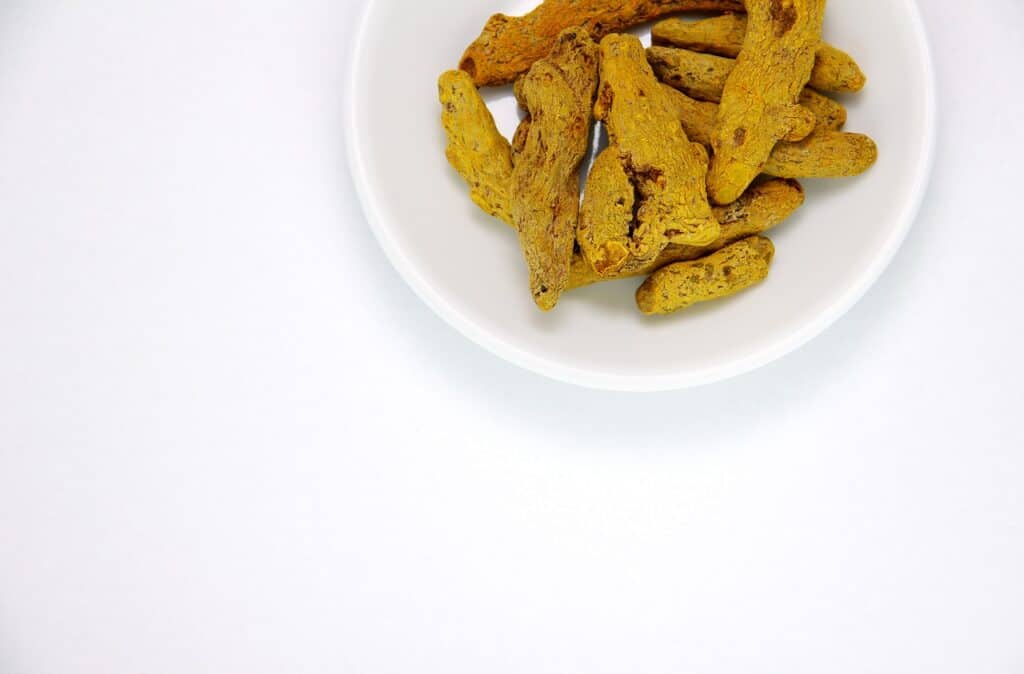
Sumac
Sumac is a kind of wild berry that occurs in the Middle-Eastern and the Mediterranean. The dry powdery form of this berry offers an interesting lemon flavor and brings a bright red pop to meat, vegetable-salads, poultry dishes, and sauces.
People in the Mediterranean region often sprinkle sumac over vegetable-salads, but the Iranians typically add this spice to kababs to provide them with an unexpected taste. Sumac is an aromatic spice that blends citrus’ flavor with saltiness to create a more intense taste. It is also used as a garnish for hummus and other mezze dishes.
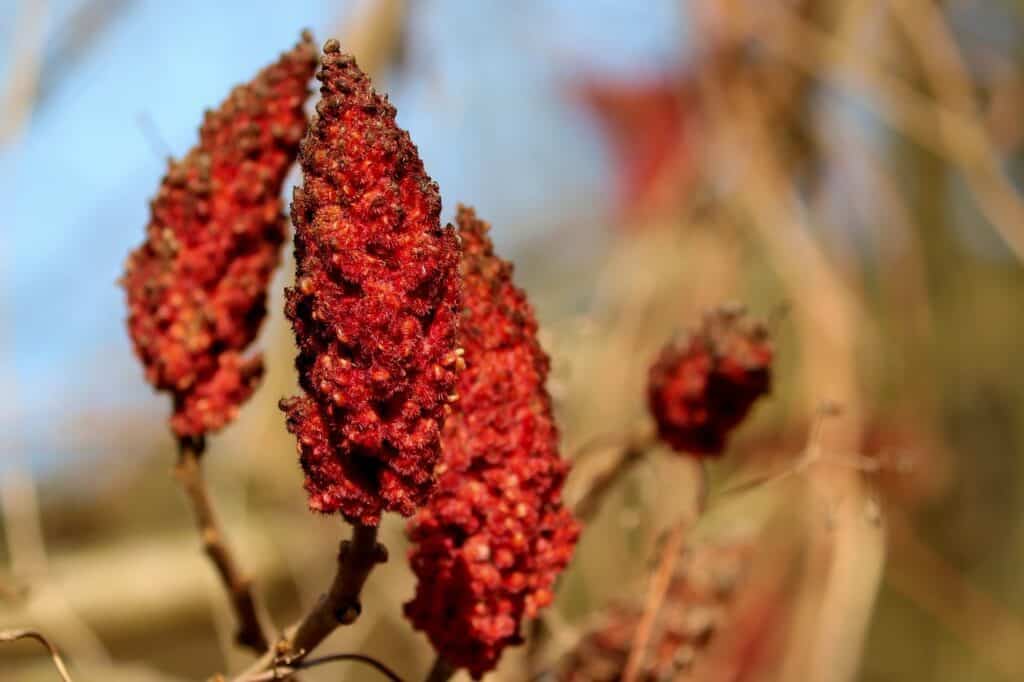
Ginger
While the ginger root is becoming increasingly popular also in the Western world, it has been used in the Persian kitchesn for centuries. Persians use powdered and dried ginger in bread, cookies, and other sweets. The fresh ginger root is diced and added to a wide range of savory dishes. It’s a warm, fragrant spice.
Tip: Since we prefer using fresh ginger but don’t use it enough to always keep it in our fridge, we always keep some peeled and diced ginger root in our freezer. This way, whenever we need a little bit for a recipe, we can just use it fresh off the freezer.
Steeped ginger tea with honey and lemon is known to have an anti-emetic effect.
Black Pepper
Black pepper is by far the most widely used “hot” seasoning in Persia. Several healing benefits have been traced to pepper, resulting from its “hot and dry” origin. Using it as a seasoning in preparations to add flavor and spicy touch to meats, seafood, vegetable/salad dressings, stews, and many such dishes is very common.
Caraway
Caraway Seeds are thin narrow, egg-shaped, greyish seeds. They have a strong anise-like taste, accompanied by a peppery sourness and a nutty sweetness. Caraway is known under many names, such as “meridian fennel” or “Persian cumin”. It is used as a seasoning in chicken or meat meals, soups and goulash dishes, and more. We recommend toasting the seeds before adding it to dishes to even more flavor out of it. Caraway is instantly identifiable as a spice in rye and pumpernickel bread and Havarti cheese. It combines well with hearty, delicious meals such as cabbage, pork, rice, sauerkraut, turnips, duck, carrots, and sausages. It is also mixed with spices such as fennel, dill, parsley, cinnamon, pepper, and thyme, to list a few of them.
Are you ready to start cooking Persian dishes? Check out the best Persian recipes here.
Cloves
Cloves are the pink flower bud of the evergreen clove plant. Once dried, their color turns brown. They are renowned for their distinctive warm, pleasant, and scented flavor. In the western world, cloves are mostly used in sweet dishes as well as in mulled wine. In Iran, cloves are also used in a range of savory dishes.
Put some whole cloves to the hot Persian Beef Stew or mix it with other Advieh spices. People also use ground cloves in mixtures of spices and whole cloves in preparations to add depth and flavor to a wide range of dishes. These little dark brown pods add a special flavor to spice curries, seasoned meat, enrich sauces like Worcestershire sauce, and even flavor spicy baked goods.
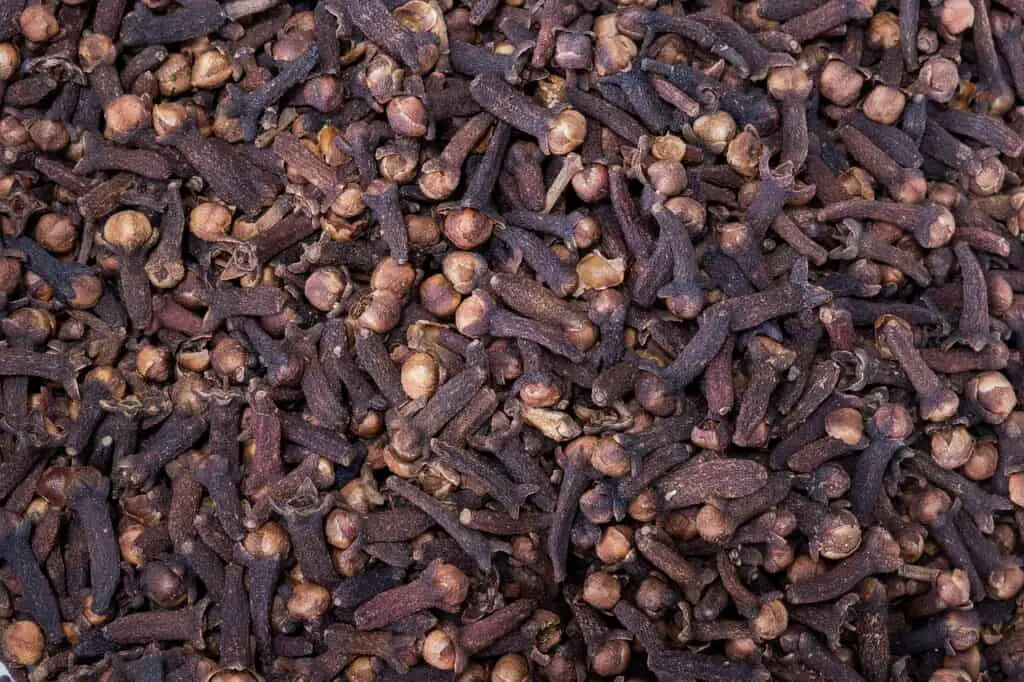
Coriander
Coriander is the seed (dried fruit) of the mature cilantro plant. The seeds have a taste of citrus when ground. Roasting at low temperature strengthens the taste.
The ground cilantro seeds are used as a spice in various savory recipes. It is one of the components in a recipe for Persian meat spices.
The herb has an aroma that combines well with several stews, salad, and soup. Coriander is the main ingredient for dishes like Ghormeh Sabzi or Ash Reshteh because of its tart taste and intense smell.
Cardamom
Cardamon is one of the primary spices in the production of Persian sweets, savory dishes, and drinks. A touch of this spicy and aromatic spice lifts any dish to an incredibly mesmerizing level. To uplift the aromas, cardamom is often accompanied by rose-water. For special celebrations like Ramadan, a Persian rice pudding is cooked with the help of Shole Zard.
Most common Persian herbs
Parsley
The peppery herb is useful as an adornment for food items, soup, salad dressing. Parsley is a widely known culinary component in food due to its strong, spicy flavor. It’s perfect with beef, legumes, and vegetables. It gives a divine taste to Salad Olivie or Felafel with a sprinkle of finely chopped parsley.
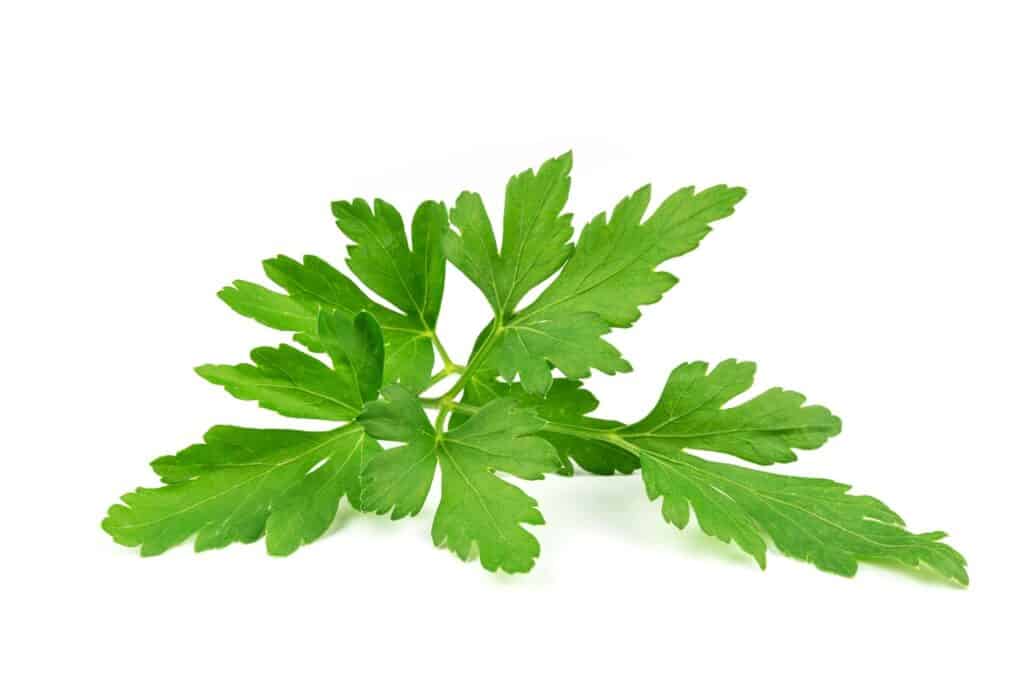
Cilantro
Cilantro is also a popular herb in the Persian cuisine with a somewhat similar taste to parsley (but it’s not the same and can’t be substituted easily). It is a herb with an aromatic, citrusy taste. While some people love the herb’s refreshing taste and scent, some can’t bear it. It’s a love it or hate it spice. Interestingly, individuals who find cilantro repulsive possess a genetic characteristic that makes them regard cilantro as “foul” or “soapy.”
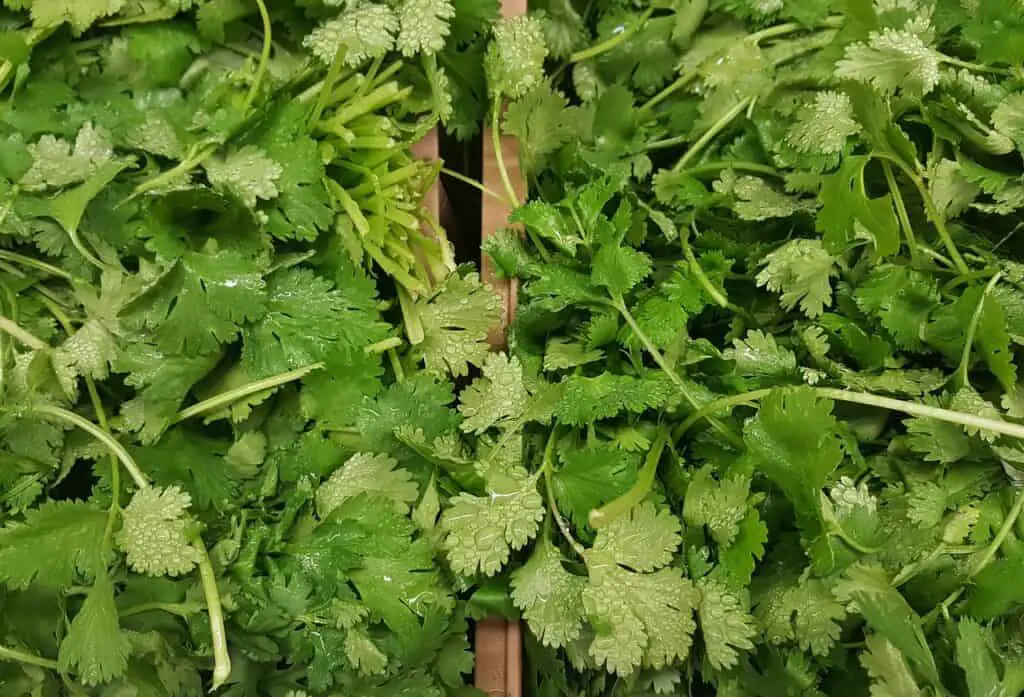
Dill
This herb looks relatively similar to fennel, although its scent and flavor are very distinct. It can be used frozen, dried, or freshly picked. Fresh dill in the Persian cuisine is used in Kuku Sabzi, Sabzi Polo and Sabzi Khordan.
In the Western cuisine, dill is mostly used to add flavor to fish dishes, especially salmon. Fresh or dried dill leaves add a slightly bitter taste and an exotic fragrance to a range of Persian dishes.
The most famous Persian dishes using dill are the classic Sabzi Polo, and Shevid Baghali Polo. Two of Iran’s favorite dishes that are usually eaten on special occasions such as Nowruz, the Persian New Year.
Mint
Mint leaves are widely used in Iran to flavor teas, cold drinks, sweets and some savory dishes.
Tarragon
The tarragon herb has a flavor somewhat similar to thyme and has a pine-like scent. The flavorful leaves of this herb are an essential part of numerous dishes in the Iranian cuisine.
Tarragon also has a wide range of positive medical effects, including relaxation of insomnia, strengthening the immune system, and avoiding cancer and diseases. The dried leaf of Tarragon has a refreshing, delicious fragrance. Try crushing them over vegetable dishes or into sauces to give them a unique taste.
Tarragon is a must-have component in preparing the popular Persian delicacy: “Koofteh Tabrizi” and “Torshi” or even in Khiar Shoor, a pickled cucumber. The herb is an excellent substitute for salt because of its mild salty flavor.
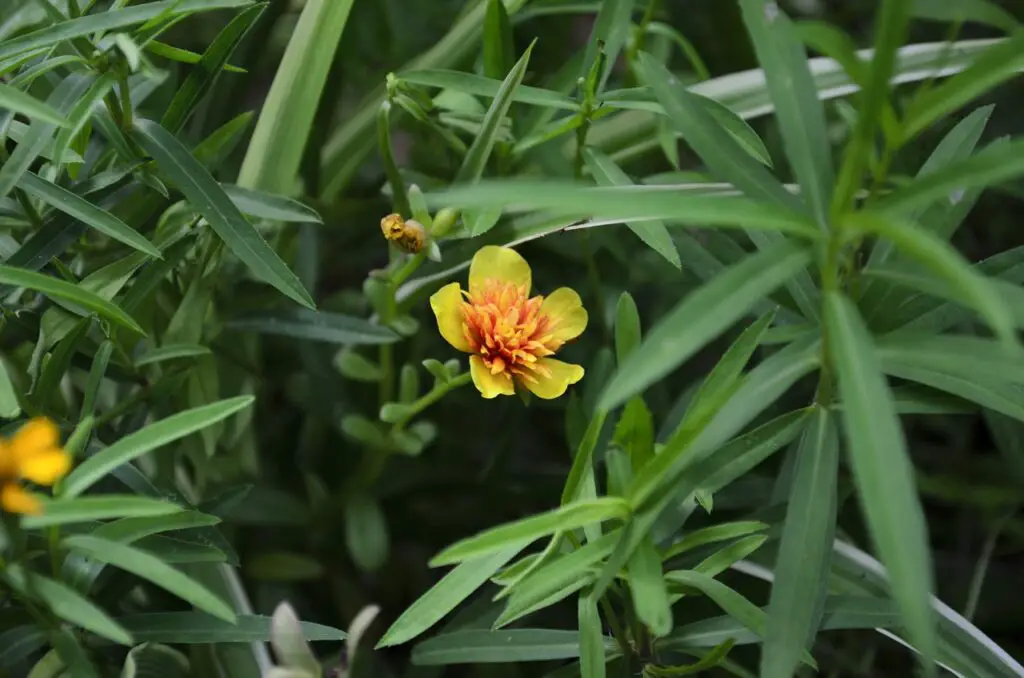
Fenugreek
Dried fenugreek leaves are great aromatic ingredient for cooking. These dried leaves have a warm, savory scent and a faintly nutty, pea-like flavor. Try crushing them over vegetable dishes or grinding them into sauces to give them a delicious flavor.
The herb has a faintly sour flavor that reminds a bit of curry. The leaves of fenugreek offer a divine flavor and scent to Ghormeh Sabzi.
Chives
The slender leaves of this herb offer an excellent semi-onion taste to several of Iran’s most famous dishes. Chives are used mostly as a garnish and as an aromatic spice. Chives are usually added at the end of the cooking procedure since they lose taste when cooked.
The taste of chives blends well with parsley, tarragon, and chervil.
Conclusion
The Persian cuisine uses a wide range of spices and the combination of different flavors is what makes the dishes so unique. Even if there is not the ONE Persian spice, the Advieh spice blend is definitely one of the most characteristic spices used in the Persian cuisine. Also rose petals and saffron are generally very typical Persian spices. Most other spices that are common in Iran, are also popular in other cuisines around the world.
If you have some spices at home, we recommend storing them in securely packed glass pots. Humidity and heat can have a negative impact on the quality of the herbs. Keeping them in cold, dry, and dark places is advisable.




